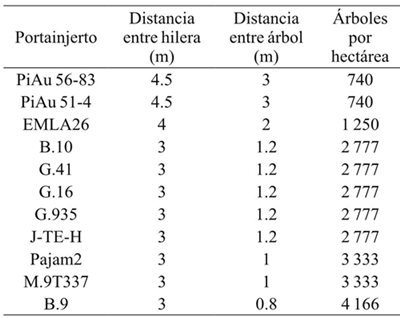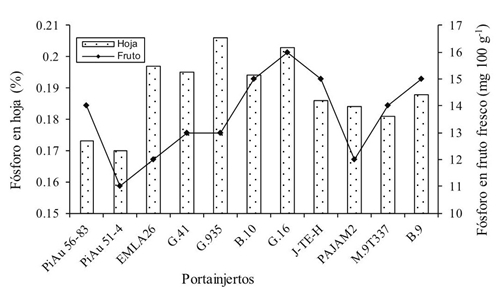Serviços Personalizados
Journal
Artigo
Indicadores
-
 Citado por SciELO
Citado por SciELO -
 Acessos
Acessos
Links relacionados
-
 Similares em
SciELO
Similares em
SciELO
Compartilhar
Revista mexicana de ciencias agrícolas
versão impressa ISSN 2007-0934
Rev. Mex. Cienc. Agríc vol.8 no.4 Texcoco Jun./Jul. 2017
https://doi.org/10.29312/remexca.v8i4.12
Articles
Response of apple rootstocks to vigor, yield efficiency and leaf and fruit concentrations of NPK
1Facultad de Ciencias Agrotecnológicas-Unidad Cuauhtémoc-Universidad Autónoma de Chihuahua. Av. Presa de la Amistad Núm. 2015. Cd. Cuauhtémoc, Chihuahua, México. CP. 31510.
2Campo Experimental Sierra de Chihuahua-INIFAP. Av. Hidalgo Núm. 1213. Cd. Cuauhtémoc, Chihuahua, México. CP. 31500.
3Universidad Autónoma de Chihuahua-Facultad de Ciencias Agrotecnologicas, Campus 1. Av. Universidad S/N, Chihuahua, Chihuahua, México. CP. 31110.
4Universidad Autónoma de Chihuahua-Facultad de Zootecnia y Ecología. Periférico Francisco R. Almada km 1. Chihuahua, Chihuahua, México. CP. 31453.
The rootstock in apple tree controls characteristics such as vigor, precocity, nutrient transport efficiency, fruit size and quality of the grafted cultivar. Currently, there are new rootstocks with potential to be used in México, but their behavior is unknown; therefore, the objectives of this paper were to know the vigor, yield efficiency and the concentration of N, P and K in leaves and fruits. The plantation was established in 2003 at La Capilla de los Remedios, Chihuahua, in order to evaluate 11 apple rootstocks of different origins, PiAu 56-83, PiAu 51-4, EMLA.26, G.935, G.41, G.16, B.10, J-TE-H, PAJAM2, M.9T337 and B.9, grafted with the Golden Delicious variety. The results obtained indicate that the rootstocks with the best yield efficiency were the most dwarfed such as M.9T337, G.41, J-TE-H, G.935 and G.16. The most vigorous rootstocks were PiAu 56-83 and PiAu 51-4. The G.16 rootstock showed high concentration of N, P and K in leaf and fruit, whereas M.9T337 showed high concentration of N in leaf. The rootstocks PiAu 56-83 and PiAu-51-4 showed high concentration of K in leaf.
Keywords: nutrients; rootstock; vigor; yield efficiency
El portainjerto en manzano controla características como vigor, precocidad, eficiencia en el transporte de nutrientes, tamaño y calidad de fruto del cultivar injertado. Actualmente existen nuevos portainjertos con potencial para ser utilizados en México, pero se desconoce su comportamiento; por lo tanto, los objetivos de este trabajo fue conocer el vigor, eficiencia de producción y la concentración de N, P y K en hoja y fruto. La plantación se estableció en 2003, en La Capilla de los Remedios, Chihuahua, para evaluar 11 portainjertos de manzano de diferentes orígenes, PiAu 56-83, PiAu 51-4, EMLA.26, G.935, G.41, G.16, B.10, J-TE-H, PAJAM2, M.9T337 y B.9, injertados con la variedad Golden Delicious. Los resultados obtenidos indican que los portainjertos con mejor eficiencia de producción fueron los más enanizantes como M.9T337, G.41, J-TE-H, G.935 y G.16. Los portainjertos más vigorosos fueron PiAu 56-83 y PiAu 51-4. El portainjerto G.16 presentó alta concentración de N, P y K en hoja y fruto, mientras que M.9T337 presentó alta concentración para N en hoja. Los portainjertos PiAu 56-83 y PiAu-51-4 presentaron alta concentración de K en hoja.
Palabras claves: eficiencia de producción; nutrientes; portainjerto; vigor
Introduction
The production of apple (Malus x sylvestris (L.) var. Domestica (Borkh) Mansf.) in México is 630 thousand tons per year, with a planted area of 61 000 ha (SIAP, 2015). Chihuahua state produces 74% of apples nationwide, with an average yield of 18.9 t ha-1. The most common cultivars are Golden Delicious and Red Delicious with 58% and 25%, respectively (SIAP, 2015).
Most of the apples are sold as fresh fruit, which has increased the interest in improving fruit quality, as evidenced by the different breeding programs that release new materials in the world (Martínez, 2009; Brown and Maloney, 2013). Several studies indicate that rootstock affects tree development, flowering phenology, yield and fruit quality in different apple cultivars (Kucukyumuk and Erdal, 2011). The rootstocks are classified by their origin in francs and clonals. Francs come frome sedes and therefore are genetically different, which leads to variability in growth and behavior of the grafted plant, in addition they are vigorous trees, that show good anchoring and adaptation to different soil types, they are used in low planting densities due to its vigor. They are susceptible to neck rot (Phytophthora cactorum), crown gill (Agrobacterium tumefaciens), woolly aphid (Erisoma lanigerum) and fire blight (Erwinia amylovora) (Parra and Guerrero, 2005).
Clonal rootstocks are obtained by genetic improvement and, once released, are asexually multiply by plots in nursery or by micro propagation. They are very uniform in vigor, show tolerance to pests and diseases, low temperatures and drought, low cold requirement, vigor control, adaptation to different soils types and ability to absorb and transfer nutrients (Robinson et al., 2014).
The rootstock affects the mineral concentration of leaves and fruits in the grafted cultivar (Tagliavini et al., 1992). Abdalla et al. (1982) reported that cv Red Delicious in dwarfing rootstocks showed higher yield efficiency and Mn concentration in the leaf, but lower K concentration than the more vigorous rootstocks. Fallahi et al. (1984) observed in cv Starkspur Golden Delicious grafted on M.26, high concentrations of Mg on leaf. The ability of nutrient uptake and translocation varies between cultivars and rootstocks, and therefore there is a differential response in plant growth, yield and fruit quality (Campeanu et al., 2009). In order to determine the nutrient uptake capacity of the rootstock/cultivar interaction, it is necessary to determine the extracted or required amount for that particular combination (Jimenez et al., 2004).
Leaf and fruit analysis have been used extensively to evaluate the nutritional status of the plant and the fruit quality, and to be able to determine the impact that the rootstock and the cultivar have on it (Nachtigall and Dechen, 2006). The flowers analysis also allows the diagnosis on early fruit development stages the nutrient status of the tree and to predict potential deficiencies. The concentration of leaf nutrients, over time, also allows to diagnose the crop requirements in the different states of fruit development (Nachtigall and Dechen, 2006; Hirzel and Best, 2009). It is also convenient to know the symptom that produces the deficiency of each element to be able to correct it, to take the nutrient to an adequate level and to avoid problems in terms of vigor, plant development and quality of harvested product. The objective of this paper was to know the vigor, the yield efficiency and the concentration of N, P and K in leafs and fruits in the cv Golden Delicious grafted on eleven clonal apple tree rootstocks.
Materials and methods
The work was carried out in an orchard established in 2003, at the Capilla de los Remedios, Chihuahua, México. The cv Golden Delicious was grafted onto 11 clonal rootstocks; B.9, B.10, M.9T337, EMLA26, Pajam2, G.16, G.935, G.41, J-TE-H, PiAu 56-83 and PiAu 51-4, with four replicates randomly distributed in the experimental batch. Trees were planted at 2.5*4.5 m, the vertical shaft conduction system was used, surface drip irrigation with emitters every 60 cm, with an expenditure of 1.78 L h-1. A wire support was established to avoid damages in the graft union and to assure a good anchorage of the trees. The experimental site showed a sandy loam texture with 58.1 sand, 25.28% silt and 16.61% clay, pH 7, 1.7% MO, 32.83% saturation, 0.615 mm cm-1 CE, 8.52% CIC. The values of nutrients found in the soil were Ca (64.37%), Mg (16.95%), K (6.75%), Na (7.62%), 40 kg ha-1 nitrates (NO3), P (32.47 ppm), Fe (30.65 ppm), Zn (2.55 ppm), Mn (45.43 ppm), Cu (1.54 ppm), B (1.28 ppm) and sulfur (S-SO4) 116.91 ppm.
Management of the orchard was performed homogeneously for all rootstocks. The fertilization was done through the irrigation system, applying 40, 20 and 60 kg of N, P and K per ha per year, distributed during the crop cycle. Weed control was carried out by applying herbicide to the row and with a machine in the street, for pests and diseases control the monitoring of apple moth was followed and applied when the method determined it, likewise for powdery mildew (P. leucotricha) and fire blight (E. amylovora).
Foliage samples were collected on three dates, June 16, July 18 and August 22, 2011, from the middle part of the tree, from the middle part of year growth shoots, without fruit, leaves without damage and with petiole. The determination of N, P and K in fruit was carried out at the time of harvest, pulp was taken from uniform fruits, without damage and medium size. The N was determined with the Micro-kjeldhal methodology, proposed by Bremner (1965). P and K were determined using the methodology proposed by Allan (1971). The trunk cross-sectional area (ASTT) was determined by measuring the trunk circumference at 20 cm above the graft union using the formula
Where: ASTT= cross-sectional area of trunk and C= circumference of the trunk. The tree top volume was obtained by applying the formula
; formula; where V= tree top volume, a= tree top width N-S, b= tree top width E-O, h= height.
The yield was obtained by dividing the total yield per tree between the ASTT, given in kg of fruit produced on cm2 of ASTT. The yield efficiency per hectare was obtained by multiplying the yield efficiency per tree (kg cm-2), by the number of trees per ha (Autio et al., 2013; Marini et al., 2014).
For statistical analysis, a completely randomized design was used, with four replicates and one tree as the experimental unit and Tukey’s means comparison at 95% confidence, using the SAS (1999) package.
Results and discussion
Vigor
PiAu 56-83 and PiAu 51-4 rootstocks were the most vigorous with 130 and 87 cm2 ASTT respectively, with statistically significant differences between them and the rest of the rootstocks. These materials can not be used for the design of high densities orchards (Marini et al., 2009; Marini et al., 2014) for the vigor that they give to the grafted cultivar. They were followed in order of vigor by EMLA 26, G.935 and G.41, with 43, 40 and 39 cm2 of ASTT respectively, with no statistical differences between them. These materials are suggested to be used in high and medium planting densities, depending on the grafted cultivar, the conduction system used and the soil fertility, factors that influence the final vigor of the tree.
G.16 and B.10 rootstocks were reported as semi-dwarfs and showed values of 34 and 33 cm2 of ASTT and did not show statistically differences between them, but with the rest of the rootstocks except for J-TE-H with 27 cm2 that was different from G.16 but statistically equal to B.10. Less vigorous or dwarfing rootstocks were Pajam2, M.9T337 and B.9 with 25, 16 and 12 cm2 respectively, with statistically significant differences between them and the rest of the rootstocks (Figure 1).
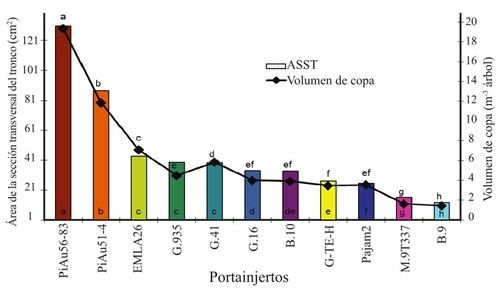
Figure 1 Cross-sectional area of the trunk (cm2) with bars and letters of significant differences at the bottom. Crown volume (m3) with lines and significant differences with letters at the top. Means with the same letter are statistically equal to each other.
The results obtained agree with Autio et al. (2008) and Marini et al. (2014) by indicating that there are rootstocks that control the vigor of the aerial part and allow the design of orchards in medium and high planting densities, but also the new materials are tolerant to pests and diseases, such as the rootstocks of Geneva series (G) that show tolerance to fire blight, neck rot and woolly aphid (Robinson et al., 2011), indicating that they can also be used in organic gardens, where pesticide use is restricted. The rootstocks PiAu 56-83 and PiAu 51-4 were those with the highest crown volume with 19 and 11 m3 respectively, with significant differences between them and the rest of the rootstocks.
They were followed in order of crown volume EMLA 26, G.41 and G.935 with 7, 5, 4.5 m3 respectively; then G.16, B.10, Pajam2, J-TE-H with 4, 3.9, 3.5 and 3.4 m3 respectively, with no significant differences between them. While the rootstocks with less crown volume were M.9T337 and B.9 with 1.6 and 1.4 m3 respectively, with significant differences between them and the rest of the rootstocks (Figure 1). A 95% correlation was found between the trunk cross-sectional area (ASTT) and crown volume. This indicates that in order to determine tree vigor it is easier and more precise to do so by taking ASTT, since this variable is not affected by pruning, while the crown volume is affected (Robinson et al., 2014).
Plantation density
Planting density is estimated based on the development of the tree during the first 10 years (Autio et al., 2013; Marini et al., 2014), sufficient time for the tree to show its development potential considering ASTT or crown volume as vigor indicators. It is suggested to plant vigorous rootstocks, such as PiAu 56-83 and PiAu 51-4 at 4.5*3 m, for 740 trees per ha. But if the producer requires planting 1 250 trees per ha, semi-dwarfs rootstocks are suggested. However, the future of new plantations in apple tree, worldwide is to use high densities, with early, dwarfing rootstocks, highly efficient for yield and good quality fruit (Table 1). One of the constraints to starting orchards in high densities is the number of trees per ha, because there is a high initial investment; therefore, some producers do not buy the trees in the nursery, but they make them themselves, therefore they lower the initial cost of the orchard. However as a disadvantage, one year at the beggining of production is lost.
Yield efficiency
The most productive rootstocks were M.9T337 and G.41 with 1 126 and 952 kg cm-2 ha-1 respectively, without showing significant differences between them. Meanwhile, the lowest yielding rootstocks were the most vigorous, such as PiAu 56-83 and PiAu 51-4 with 343 and 203 kg cm-2 ha-1, the latter being significantly different from M.9T337 and G.41 (Figure 2). These results agree with studies carried out by Marini et al. (2009) and Parra and Guerrero (2005), who indicate that yield efficiency is affected by the rootstock vigor, and as the rootstock is more vigorous, the yield efficiency. Robinson et al. (2003) mention that vigorous trees produce more kilograms of fruit than smaller ones, but the dwarfing trees increase planting density, increasing yield per unit area and yield efficiency.
Nitrogen
According to the results obtained from the foliar tissue sampling performed in pre harvest, a decrease in N from June to July for all rootstocks was found, except for B.9, which showed upward trend over time. Most rootstocks maintained a downward trend until August, with the exception of EMLA 26 and M.9T337, which increased slightly from July to August (Figure 3). This downward trend of N coincided with that reported by Cheng and Raba (2009), who mentioned that this element decreased from flowering to harvest. Casierra et al. (2003), found an increase in the N content in leaves between 16 and 46 days after full bloom (ddpf), possibly due to the transport of the element from the reserve organs to the new growing organs.
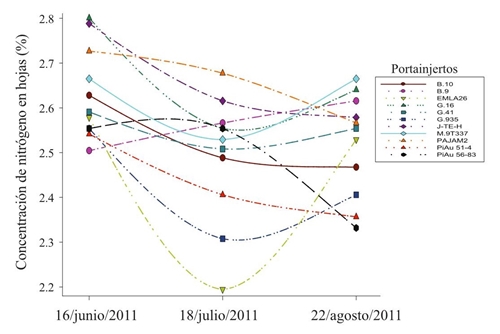
Figure 3 Concentration of N (%) in leaves over time in Golden Delicious apple grafted to different rootstocks.
For Faby and Naumann (1987), the N concentration was greater one week after full bloom than the amount of N required for the new sprout. However, Halbrendt (2013) indicates that all rootstocks are within the normal ranges, 1.8 to 2.8%, of this element content based on leaf dry matter. Hoying et al. (2004) mention that the optimum N content ranges for Golden Delicious apple is between 2.4 and 2.6%. However, Puertas (1997) pointed out that the ranges for the Cuauhtémoc region, Chihuahua, in August were 1.90 to 2.25%.
The results obtained from N in this paper fluctuated between 2.33% and 2.66%, where the PiAu 56-83 rootstock showed the lowest concentration and the M.9T337 showed the highest value, without significant differences between them, which can be deduced that in western conditions of Chihuahua state in which they developed, all rootstocks had the same capacity to absorb and transfer N from the root to the leaves, without showing deficiencies of this element in the evaluated period.
In Figures 3 and 4 it is shown that the M.9 and G.16 rootstocks were the ones with the highest leaf concentration of this element for August, with values of 2.66 and 2.64%, respectively. However, fruits obtained from the plants grafted on the G.41 rootstock were the ones that showed the highest concentration of this element with 49.2 mg100 g-1 fresh weight, followed by G.16, M.9T337 and G.935 with values of 49, 45, 44 mg100 g-1 respectively. The rootstocks PiAu 51-4 and PiAu 56-83 showed the lowest leaf concentration of N with 2.35 and 2.33%, respectively and in fruit 38.5 and 37.5 mg 100 g-1 of fresh weight, respectively.
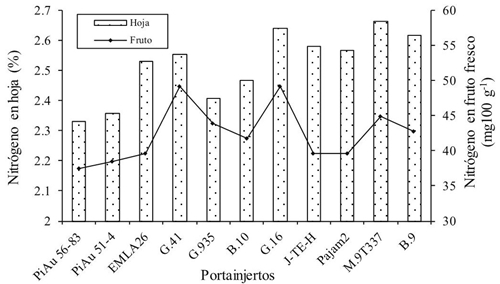
Figure 4 Concentration of N (%) in leaf and fruit (mg 100 g-1 fresh weight) in Golden Delicious apple grafted to different rootstocks.
The above-mentioned data indicate that the more dwarf rootstocks presented higher N concentrations than vigorous ones (Figure 5), perhaps because vigorous rootstocks demand more N for vegetative growth than the dwarfs (Parra and Becerril, 1999).
Phosphorus
Variability was found in P concentrations in leaves. M.9T337, J-TE-H, PiAu 51-4, G.16, Pajam2 and PiAu 56-83 rootstocks showed increases in July and then decreased in August (Figure 6). This trend coincided with the study by Casierra et al. (2003), in which P concentration in the leaf tissue increased 0.9% between 16 and 46 ddpf and then reduced to 0.2%, and remained around this concentration until the time of harvest. In the G.935, G.41, and B.10 rootstocks, a slight decrease of P was found in July and then a rise in August. EMLA26 and B.9 rootstocks maintained an upward trend over time, until August with values of 0.197 and 0.188%. This variation can be attributed to genetic variability among rootstocks to absorb phosphorus, according to studies by Sparks (1989). Similarly, Parra and Becerril (1999) mentioned that P concentration in the leafs can be affected by the rootstock, cultivar/rootstock interaction and locality. Cheng and Raba (2009) indicated that this element decreases from flowering to harvest. However, according to the normal ranges of P, cited by Hoying et al. (2004) and Puertas (1997), all rootstocks were found within normal ranges (Tables 5 and 6) 0.15 to 0.3%, 0.13 to 0.33% and 0.165 to 0.295% respectively for August.
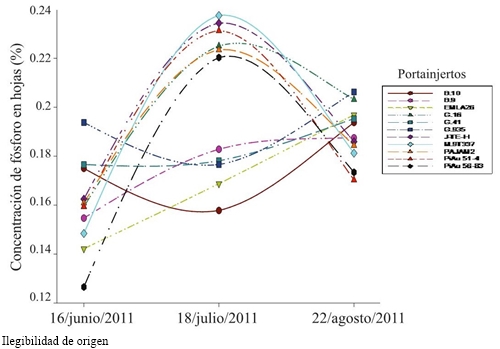
Figure 6 Concentration of P (%) in leaves over time in Golden Delicious Apple trees grafted to different rootstocks.
Figure 7 shows that the G.935, G.16, EMLA 26 and G.41 rootstocks were the ones with the highest foliar concentration of this element with values of 0.206%, 0.203%, 0.197% and 0.195%, respectively. PiAu 51-4 had the lowest concentration of both foliar (0.17%) and in fruit (11 mg 100 g-1). G.16 rootstock was the one that reached the highest concentration in fruit with a value of 16 mg 100 g-1 of fresh weight.
Potassium
K concentration in the leaf was higher in June and decreased over time until August (Figure 8). This downward trend was found in most of the rootstocks except for Pajam 2, which increased in August but not significantly. These results agree with Cheng and Raba, (2009), who found a decrease of this element from flowering to harvest in the cv Gala/M.26. Casierra et al. (2003) found constant values of K, but above the range reported by Faust (1989), who states that between 1.5 and 1.8% of this element content of in dry matter, is considered adequate for physiological processes, where K is related. Possibly values greater than 1.8% of Potassium found by Casierra et al. (2003), might be due to the fact that the study was performed on cv Anna/MM.106 and according to Tagliavini et al. (1992), the more vigorous rootstocks accumulate more K.
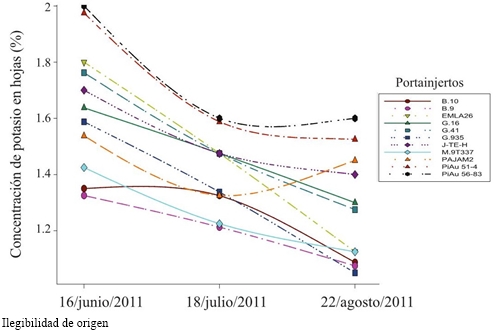
Figure 8 K concentration (%) in leaves over time in Golden Delicious apple trees grafted to different rootstocks.
In this research, most rootstocks were found within the ranges reported by Puertas (1997) as normal, with the PiAu 56-83 rootstock being at upper limit with values of 1.55%.
On the other hand, according to the tables of Hoying et al. (2004), the G.41, EMLA26, B.9, B.10, G.935 and M.9T337 rootstocks, with values of 1.25, 1.15, 1.1, 1.075, 1.05, 1.05% respectively, were found in deficiency levels; which coincided with that reported by Parra and Becerril (1999), who in their research in Bachiniva, Chihuahua, found low leaf K levels for B.9 and EMLA26 rootstocks. However, Abdalla et al. (1982) found high concentrations of K in leaves of cv Delicious/M.26.
Figure 9 shows that PiAu 56-83 rootstock had the highest concentration of this element in the leafs for August; however, it was one of the lowest in translocating the K to the fruit. Otherwise found in M.9T337rootstock, where it showed a high concentration of K in fruit, although the leaf showed the lowest concentration.
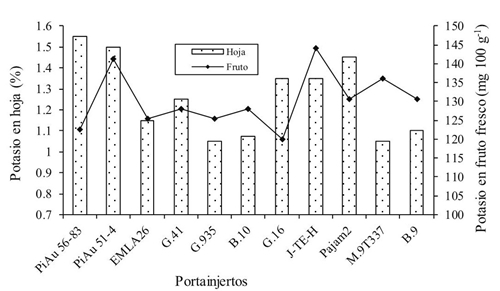
Figure 9 K concentration (%) on leaf of August 22 and fruit at harvest in fresh weight in different rootstocks ordered by vigor and grafted with Golden Delicious.
The rootstocks that obtained the highest concentration of K in fruit were J-TE-H, followed by PiAu 51-4 and M.9T337 with values of 144, 141 and 136 mg 100 g-1 fresh weight, respectively. The lowest concentration was obtained by G.16 with 120 mg 100 g-1 fresh weight. Based on the information generated by Puertas (1997), all rootstocks were within the optimal range established for the Cuauhtémoc region, Chihuahua, with 197 mg 100 g-1 fresh weight.
Conclusions
Rootstocks that can be used for the design of orchards at high planting densities are B.9, M.9T337, Pajam2, G.16, G.41, J-TE-H and B.10.
The best producyieldtion efficiency was obtained in M.9T337 and G.41.
A high concentration of N in leaf and fruit was found in M.9T337, G.16 and B.9.
High P concentration in leaf was found for G.41 and G.16; and high fruit P concentration for B.10.
The G.16 rootstock showed a high concentration of N, P and K in leaf and N and P in fruit.
The rootstocks PiAu 56-83 and PiAu 51-4 showed low concentration of N and P in leaf, but high in K.
Literatura citada
Abdalla, O. A.; Khatamian, H. and Miles, N.W. 1982. Effect of rootstocks and interstems on composition of “Delicious” apple leaves. J. Amer. Soc. Hort. Sci. 107(5):730-733. [ Links ]
Allan, J. E. 1971. The preparation of agricultural samples for analysis by atomic absorption spectroscopy. Varian Techtron, Walnut Creek, California. 143 p. [ Links ]
Autio, W.; Robinson, T.; Cowgill, W.; Hampson, C.; Kushad, M.; Parra, Q. R.; Perry, R. and Rom, C. 2008. Performance of ‘Gala’ apple trees on Supporter 4, P.14, and different strains of B.9, M.9 and M.26 rootstocks: A five-year report on the 2002 NC-140 apple rootstocks trial. J. Amer. Pom. Soc. 65(2):119-128. [ Links ]
Autio, W.; Robinson, T.; Archibold, D.; Cowgill, W.; Hampson, Ch.; Parra. Q. R. and Wolfe, D. 2013. Gala apple trees on supporte 4, p.14, and different strains of b.9, m.9, and m.26 rootstocks: final 10-year report on the NC-140 apple rootstocks trial. J. Amer. Pom. Soc. 67:.62-71. [ Links ]
Bremner, J. M. 1965. Total nitrogen. Methods of soil analysis. Part 2. Agronomy 9. American Society of Agronomy. Madison, Wisconsin. 1149-1178 pp. [ Links ]
Brown, S. K. and Maloney, K. E. 2013. An update on apple cultivars, brands and club-marketing. New York Fruit Quarterly. 21(1):3-10. [ Links ]
Casierra, P. F.; Cortés, L. F.; Ramírez, J. y Castro, F. H. 2003. Estado nutricional de árboles de manzano “Anna”, durante la estación de crecimiento en los altiplanos colombianos. Contenido de elementos minerales. Agron. Colomb. 21(1):5-82. [ Links ]
Cheng, L. and Raba, R. 2009. Accumulation of macro and micronutrients and nitrogen demand-supply relationship of “Gala”/”Malling 26” apple trees grown in sand culture. J. Amer. Soc. Hort. Sci. 134(1):3-13. [ Links ]
Campeanu, G.; Gabriela, N. and Darjanschi, G. 2009. Chemical composition of the fruits of several apple cultivars growth as biological crop. Not. Bot. Hort. Agrobot. Cluj. 37(2):161-264. [ Links ]
Faby, R. and Naumann, W. D. 1987. Die bedeutungder einlagerung von reservatoffen im herbs bei apfelbaumen, dargastellt and entblatterungsversuchen. Erwerbsobstbau 29 (2):57-60. [ Links ]
Faust, M. 1989. Physiology of temperature zone fruit trees. John Willey & Sons Publicaciones. Nueva York. 132 p. [ Links ]
Fallahi, E.; Westwood, M. N.; Chaplin, M. H. and Richardson, D. G. 1984. Influence of Apple rootstocks, K and N fertilizers on leaf mineral composition and yield. J. Plant Nutr. 7:1161-1177. [ Links ]
Jimenez, S.; Garin, A.; Betran, J. A.; Gogorcena, Y. and Moreno, M. A. 2004. Flower and leaf analysis for nutritional prognosis of sweet cherry tree, influence of different rootstocks. J. Plant Nutr. 27(4):701-712. [ Links ]
Halbrendt, J. M. 2013. Pennsylvania 2012-2013: tree fruit production guide. College of Agricultural Science, Pennsylvania State University. 340 p. [ Links ]
Hirzel, J. F. and Best, S. 2009. Effect of two rootstock selections on the seasonal nutritional variability of Braeburn apple. UC Davis: In: The proceedings of the international plant nutrition colloquium XVI. Poster núm. 1375. [ Links ]
Hoying, S. A.; Fargione, M. and Lungerman, K. 2004. Diagnosing apple tree nutritional status: leaf analysis interpretation and deficiency symptoms. New York Fruit Quarterly. 12(1):6-18. [ Links ]
Kucukyumuk, Z. and Erdal, I. 2011. Rootstock and cultivar effect on mineral nutrition, seasonal nutrient variation and correlations among leaf, flower and fruit nutrient concentrations in apple trees. Bulg. J. Agric. Sci., 17: 633-641 [ Links ]
Marini, R.P.; Black, B.; Crassweller, R. M.; Domoto, C. P. A.; Hampson, S.; Johnson, K.; Kosola, S.; McArtney, J.; Masabni, R. M.; Parra, Q. R.; Robinson, T. and Rom, C. R. 2009. Performace of Golden Delicious apple on 23 rootstocks at 12 locations: a five-year summary of the 2003 NC-140 dwarf rootstocks trial. J. Amer. Pom. Soc. 63 (3):115-127. [ Links ]
Marini, R.P.; Black, B.; Crassweller R. M.; Domoto, C. P. A.; Hampson, R. M.; Robinson, T. Stasiak, M. and Wolfe, D. 2014. Performance of ՙGolden Delicious' Apple on 23 Rootstocks at Eight Locations: A Ten-Year Summary of the 2003 NC-140 Dwarf Rootstock Trial. J. Amer. Pom. Soc. 68(2):54-68. [ Links ]
Martínez, M. A. 2009. Comportamiento de 11 portainjertos clonales de manzano injertados con Golden Delicious en Cuauhtémoc, Chih. Tesis de Maestría en Ciencias de la productividad Frutícola. Facultad de Ciencias Agrotecnológicas. Universidad Autónoma de Chihuahua. Chihuahua, Chihuahua. 52 p. [ Links ]
Nachtigall, G. R. and Dechen, A. R., 2006. Seasonality of nutrients in leaves and fruits of apple trees. Sci. Agric (Piracicaba, Braz.). 63(5):493-501. [ Links ]
Parra, Q. R. A. y Becerril, E.R. 1999. Efecto de portainjertos de manzano en la concentración nutrimental de la hoja en el cv. Starkspur Supreme Delicious. Terra 17(1):1-7. [ Links ]
Parra, Q. R. A. y Guerrero, P. V. M. 2005. Descripción de portainjertos de manzano y diseño de plantaciones con portainjertos clonales. Folleto Técnico Núm. 13 INIFAP-Sierra de Chihuahua. 35 p. [ Links ]
Puertas, R. J. L. 1997. Dinámica nutricional del manzano como antecedente para el establecimiento de sistemas de fertirrigación. Tesis de Maestría en Ciencias, Facultad de Ciencias Agrotecnológicas. Universidad Autónoma de Chihuahua. Chihuahua, México. 129 p. [ Links ]
Robinson, T. L.; Hoying, S.; Fargione, M. and Lungerman, K. 2003. On-Farm Trial of the Cornell Geneva Apple Rootstocks in New York. Compact Fruit Tree. 36(3):70-73. [ Links ]
Robinson, T. L.; Fazio, G.; Hoying, S.; Miranda, M. and Lungerman, K. 2011. Geneva apple rootstock performance in New York State and Progress in Commercialization. Compact Fruit Tree. 44(3):22-29. [ Links ]
Robinson, T. L.; Fazio, G. and Aldwinckle, H. S. 2014. Characteristics and performance of four new apple rootstocks from the Cornell-USDA apple rootstock breeding program. Acta Hortic. 1058:651-656. [ Links ]
SAS Institute, Inc. 1999. SAS/STAT User’s Guide. Release 6.03. Cary, NC. [ Links ]
Sharma, D. D. and Shauhan, J. S. 1991. Effects of different rootsocks and training system on the mineral composition of “Delicious” apple leaves. J. Hort. Sci. 66:703-707. [ Links ]
SIAP (Servicio de Información Agroalimentaria y Pesquera). 2015. Secretaría de Agricultura, Ganadería, Desarrollo Rural, Pesca y Alimentación (SAGARPA). Anuario Estadístico de la Producción Agrícola. http://www.siap.gob.mx. [ Links ]
Sparks, D. 1989. Current recommendations for leaf P levels too low, study shows. Pecan South. 21(1):9-13. [ Links ]
Tagliavini, M.; Scudellari, D.; Marangoni, B.; Bastianel, A.; Franzin, F. and Zamborlini M. 1992. Leaf mineral composition of apple tree: sampling date and effects of cultivar and rootstocks. J. of Plant Nut. 15:605-619. [ Links ]
Received: February 2017; Accepted: May 2017











 texto em
texto em 

